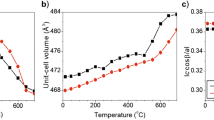Summary
The thermal breakdown of topaz, Al2SiO4(F, OH)2, has been studied, by X-ray diffraction, thermal analysis and electron microscopy. The results show the formation, at temperatures of 1000°C and above, of partly oriented mullite, (Al2O3)3–4 (SiO2)2, and silica. The silica formed during the reaction occurs as partly oriented cristobalite and/or as a siliceous glass, which at the temperature of the reaction must have been mobile, the minimum melting point in the silica-alumina system being reduced by the presence of fluorine. In certain cases, when hydroxyl-bearing topaz was heated to form mullite and subsequently reheated to higher temperatures, the mullite was replaced by partly oriented corundum.
The orientational control is believed to be by epitaxy on close-packed planes in the topaz. Mullite does not possess any planes which are described as close-packed, but consideration of the area of oxygen ion (treating each as a hard sphere) through which a plane cuts, gives a measure of the degree of approximation to close packing of planes within the structure, and helps to explain the mullite orientation. The orientation of the silica and corundum is consistent with the explanation of the orientation of the mullite.
A multi-stage reaction mechanism is proposed involving the dehydroxylation of hydroxylbearing topaz, the loss of fluorine by an inhomogeneous mechanism with the counterdiffusion of silicon and aluminium, and further loss of fluorine homogeneously.
Zusammenfassung
Die maximale thermische Stabilität von Topas Al2SiO4(F, OH)2 wurde mit Röntgendiffraktion, Differential-Thermoanalyse und Elektronenmikroskopie untersucht. Die Ergebnisse zeigen, daß bei Temperaturen von 1000°C und darüber teilweise orientierter Mullit (Al2O3)3–4 (SiO2)2 und SiO2-Phasen entstehen. SiO2 liegt einerseits als teilweise orientierter Cristobalit, andererseits auch in amorpher Form als Glas vor SiO2 muß bei den angegebenen Reaktionstemperaturen mobil gewesen sein; dies wird auf die Herabsetzung des Schmelzpunktes in Gegenwart von Fluor zurückgeführt. Bei erneuter Aufheizung in noch höhere Temperaturbereiche konnte in einigen Fällen ein Ersatz des Mullits durch teilweise orientierten Korund beobachtet werden.
Es wird angenommen, daß die Verwachsungen auf Epitaxie-Beziehungen an dichtestgepackten Netzebenen des Topas zurückgeführt werden können. Mullit besitzt keine dichtestgepackten Flächen; betrachtet man jedoch die Fläche der Sauerstoff-Ionen als “hard sphere”, die von einer Fläche geschnitten wird, so kann dies als Maß der Annäherung an dichteste Besetzung der Flächen innerhalb der Struktur gelten, und so zum Verständnis der Mullit-Orientierung beitragen. Die Orientierung von SiO2 und Korund stimmt mit dieser Interpretation überein.
Als Entstehungsmechanismus wird ein mehrstufiger Reaktionsablauf angenommen: Dehydroxylation des Topas, ein teilweiser Verlust von Fluor, verbunden mit einer gegenläufigen Diffusion von Silizium und Aluminium, und anschließend ein weiterer, homogener Verlust des Fluor.
Similar content being viewed by others
References
Bradley, R. S., Schroeder, F. W., Keller, W. D., 1940: Study of the refractory properties of topaz. J. Amer. Ceram. Soc.23, 265–270.
Bragg, L., Claringbull, G. F., 1965: Crystal Structures of Minerals. London, England: G. Bell and Sons Ltd.
Brindley, G. W., Nakahira, M., 1959: The kaolinite—mullite reaction series I-III. J. Amer. Ceram. Soc.42, 311–324.
Burgess, B. C., 1942: Topaz development as a source of alumina. Bull. Amer. Ceram. Soc.21, 135–139.
Burnham, C. W., 1963: Refinement of the crystal structure of sillimanite. Z. Krist.118, 127–148.
— 1964: Crystal structure of mullite. Carnegie Inst. Wash. Year Book63, 223–228.
Butler, S. A., 1972: Breakdown Reactions in the Humite Mineral Group. Ph.D. Thesis, University of Cambridge, England.
Cameron, W. E., 1977: Composition and cell dimensions of mullite. Bull. Amer. Ceram. Soc.56, 1003–1007, 1011.
Champness, P. E., 1968: The Nature of Oxidation Processes in Certain Mineral Systems. Ph.D. Thesis, University of Cambridge, England.
Fries, C., Jr., 1942: Topaz deposits near the Brewer Mine, Chesterfield County, South Carolina. U.S. Geol. Surv. Bull.936c 59–78.
Frondel, C., 1962: Dana's “The System of Mineralogy” 7th ed., Vol. 3, Silica Minerals. New York: J. Wiley and Sons Inc.
Günter, J. R., Oswald, H. R., 1969: Electron-induced decomposition of tin (IV) sulphide in the electron microscope controlled by epitaxy on inner lattice planes. J. Appl. Cryst.2, 196–199.
Hampar, M. S., 1972: Thermal and electron beam induced breakdown of topaz. Electron Microscopy and the Structure of Materials (Proc. 5th International Materials Symposium, Berkeley, California, 1971) (Thomas, G., ed.), pp. 1256–1266. University of California Press.
— 1973: Topaz: Properties and Breakdown. Ph.D. Thesis, University of Manchester, England.
—,Zussman, J., 1983: Damage of topaz and other minerals in the electron microscope. Tschermaks Min. Petr. Mitt.31, 27–37.
Iwai, S., Akao, M., Nakagawa, Y., Isobe, M., Ossaka, J., 1971: Thermal decomposition of topaz from Naegi, Japan. Bull. Tokyo Inst. Technol. No. 103, 29–36.
Kôzu, S., Ueda, J., 1929: Optical and thermal properties of topaz from Naegi, Japan. Sci. Rep. Tohoku Univ. Ser. 3,3, 161–170.
Levin, E. M., Robbins, C. R., McMurdie, H. F., 1969: Phase Diagrams for Ceramists, 2nd ed. The American Ceramic Society, Columbus, Ohio.
McVay, T. N., Wilson, H., 1943: Substitution of topaz, domestic kyanite and synthetic mullite-corundum for India kyanite, I–III. J. Amer. Ceram. Soc.26, 252–266.
Pardee, J. T., Glass, J. J., Stevens, R. E., 1937: Massive low-fluorine topaz from the Brewer Mine, South Carolina. Amer. Min.22, 1058–1064.
Pole, G. R., 1944: Calcination of topaz in a rotary kiln. J. Amer. Ceram. Soc.27, 181–185.
Ribbe, P. H., Gibbs, G. V., 1971: The structure of topaz and its relation to physical properties. Amer. Min.56, 24–30.
—,Rosenberg, P. E., 1971: Optical and X-ray determinative methods for fluorine in topaz. Amer. Min.56, 1812–1821.
Scheringer, C., 1971: A method of fitting a plane to a set of points by least squares. Acta Cryst.B27, 1740–1742.
Stuckey, J. L., Amero, J. J., 1941: Physical properties of massive topaz. J. Amer. Ceram. Soc.24, 89–92.
Taylor, H. F. W., 1962: Homogeneous and inhomogeneous mechanisms in the dehydroxylation of minerals. Clay Min. Bull,5, 45–55.
Author information
Authors and Affiliations
Additional information
With 7 Figures
Rights and permissions
About this article
Cite this article
Hampar, M.S., Zussman, J. The thermal breakdown of Topaz. TMPM Tschermaks Petr. Mitt. 33, 235–252 (1984). https://doi.org/10.1007/BF01082671
Received:
Accepted:
Issue Date:
DOI: https://doi.org/10.1007/BF01082671



